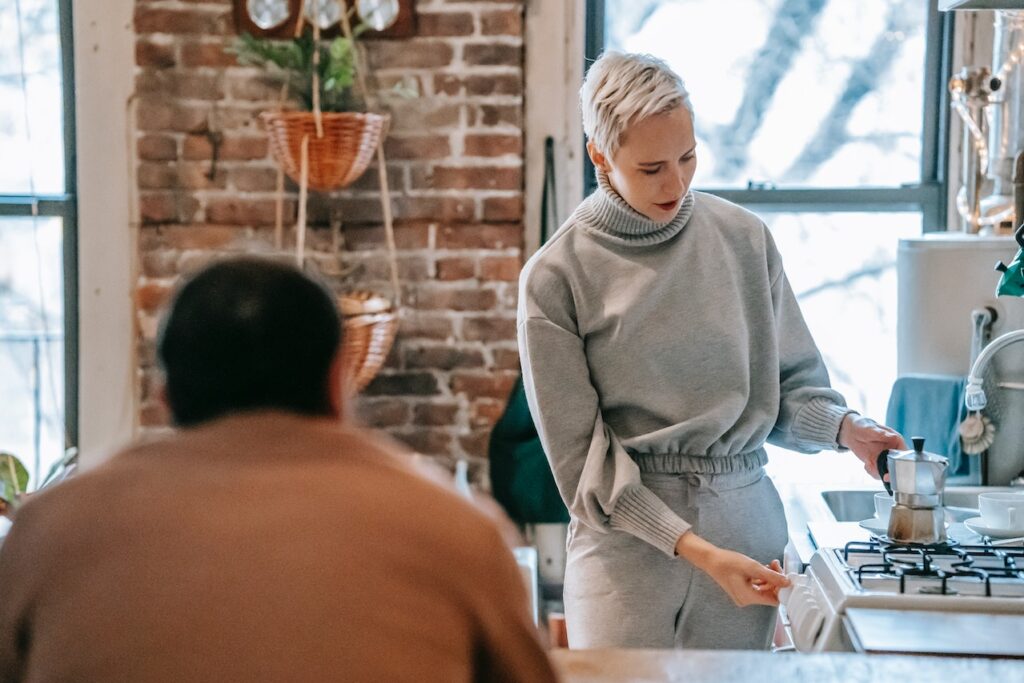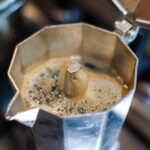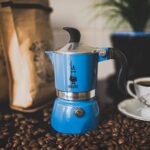How do you determine when your Moka pot is done brewing? It sounds as if it should be simple —listen for the liquid to stop bubbling. At the same time, that’s not always a reliable indicator. So today, I’ll take a closer look at different methods for knowing when the pot is done brewing.
Contents
How Do You Know When a Moka Pot Is Done?
You will know when a Moka pot is done when it starts making hissing, gurgling, and bubbling noises within 2 to 15 minutes. You will also notice that the pouring coffee smells stronger and changes color from brown to a light honey color. This is the last liquid from the lower chamber pushing through the grounds.

Wait until no more liquid enters the collector and the coffee splatters in the tower. At that time, the pot’s brewing process is complete. Immediately remove it from the heat and run cold water over it to stop the brewing.
What Factors Determine How Long a Moka Pot Takes to Brew
The best way to brew your own pot coffee is by learning how long it takes to brew with your particular model and then adding that time to your morning routine. Several factors will determine how long it takes for your pot to brew:
Heat Level
The temperature of the heat source is one of the most important factors determining how long it takes for your pot to brew. The ideal temperature for brewing is between 195°F and 205°F.
If you use a lower temperature, it will take longer for your coffee maker to produce the required amount of pressure to extract the flavor from the grounds. If you use a higher temperature, you may burn your grounds, resulting in bitter-tasting coffee.
Grind Size
Secondly, the size of your grinds determines how long it takes to brew in your pot (fine grinds brew longer, and coarse grinds brew more quickly).
Coffee Maker Size
The size of your coffee maker also determines how long it takes to brew. A small size Moka pot will take less time than a big one because less water needs to be heated and boiled to produce steam that pushes through the filter and into the upper chamber, where you can pour out your delicious espresso!
Water Temperature
Another important aspect that affects how long it takes for your pot to brew is its temperature. Suppose you use cold water instead of boiling water.
In that case, this will slow down the process considerably since cold water needs more time to reach boiling point than hot water does – so make sure that before pouring any water into your pot, it’s already at a rolling boil!
Brewing Tips and Tricks
There are some tips and tricks that you should follow to make the perfect cup of coffee:
- Tap the side of the filter basket: When you tap the side of your filter basket, it will loosen any grounds that may have stuck around the filter’s edges
- Don’t grind too fine: If you grind too fine, it can cause over-extraction, resulting in bitterness
- Don’t fill past the release valve since the water won’t be able to escape, and your brew will come out diluted and weak
- Clean under the rubber seal to prevent mold or mildew from growing there and contaminating your next batch of coffee
- Descale if you’ve got hard water to prevent calcium deposits from causing scale build-up in your filter basket
- Use freshly ground coffee beans. The fresher they are, they will taste better in your final brew
So Should You Use High or Low Heat?
To make a great cup of coffee in your pot, you must know how to heat it properly. Here are some tips on how to use high or low heat with your pot:

High Heat Is Best for Brewing Espresso
You can use high or low heat with your pot, though if you want to brew espresso, it’s best to use high heat, as this will extract more flavor from the coffee grounds. Low heat takes longer and may need to be stronger to brew espresso properly.
Use Low Heat When You Want Full-Flavored Coffee
If you want full-flavored coffee instead of espresso, try using low heat instead of high. This will ensure that all the flavors are extracted from your grinds without burning them or drying them out too much.
Related Questions
Is My Moka Pot Supposed to Whistle?
Unlike stovetop kettles, Moka pots are not supposed to whistle when they are done brewing. The brewing process will be complete when you hear gurgling and hissing sounds.
Can a Moka Pot Explode?
A Moka pot can explode if it is not cleaned properly or maintained. After every use, the pot should be washed in hot, soapy water, and the gasket should be replaced every time. You should do this more often if you use the pot frequently.
Conclusion
To know when the Moka pot is done brewing, listen for hissing, gurgling, and bubbling sounds and look out for a light honey color. The time it takes to brew espresso depends on the following factors: heat level, grind size, coffee maker size, and water temperature.


